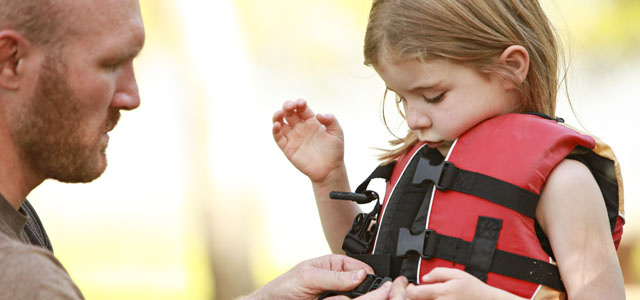Choosing the Best Life Jacket for Fishing
By Lauren Seidl
Feb 08, 2017
Life jackets are a key part of boating safety. Learn what features to look for in fishing life jackets and how to adjust your life jacket for a proper fit.
No matter how you choose to enjoy the water, life jackets are a key part of boating safety. A life jacket, or PFD (personal flotation device), allows you to stay afloat if you fall into the water. Boating laws require each passenger to have an approved life jacket when in a boat, and children should be wearing them. Be sure to check with your state agency for boating laws information in your area.
The U.S. Coast Guard groups PFDs into several main categories. These categories can help you decide which type of PFD you need, but additional features can make life jackets more comfortable for specific activities. Watch for these features if you mainly intend to use your life jacket while fishing.

Pockets & Gear Loops: Life jackets designed for fishing often have zip pockets and gear loops. Pockets can act as mini tackle boxes to hold lures, flies, pliers and other fishing tools. You can also store a whistle and small flashlight in a pocket for safety. Gear loops work the same way, but allow you to store tools by attaching them to the outside of your life jacket rather than within a pocket.
Panel Positioning: If you enjoy kayak fishing, look for a life jacket with a high back panel. The back panel of a kayaking life jacket sits just above the kayak for maximum comfort. Look for breathable, mesh panels if you plan to fish in the heat.
Inflatable: Using an inflatable PFD rather than one that is inherently buoyant is one way to keep bulk at a minimum. Inflatable PFDs are designed to be inflated once you are already overboard, usually with a small pull tab. Inflatable life jackets, which are designed for adult use only, are best used in calm waters rather than in fast-moving rivers or streams.

To correctly fasten and fit your life jacket, start by positioning it midway around your torso. From there, fasten the bottom buckle and zip the front-entry zipper. For life jackets that have more buckles along the torso, continue buckling from the bottom up and then tighten in the same order. Shoulder straps (if applicable) should be the final part of the life jacket to be adjusted.
You can test the fit of your life jacket by placing your thumbs underneath the shoulder straps and pushing up. The life jacket should stay in place if it is fitted correctly.
Now that you know what to look for in choosing and fitting a fishing life jacket, you are better prepared to have a safe and comfortable day on the water! For more information about life jackets, take a look at our life jacket buying guide.
This post is part of a series of sponsored content with Sierra Trading Post.
The U.S. Coast Guard groups PFDs into several main categories. These categories can help you decide which type of PFD you need, but additional features can make life jackets more comfortable for specific activities. Watch for these features if you mainly intend to use your life jacket while fishing.


Fishing Life Jacket Features
Low-Bulk Design: Look for life jackets that have flotation panels in the front and back with a low-bulk design around the shoulders, neck and sides. Having minimum bulk and fabric toward the top and sides of the life jacket will allow your arms to be more mobile so you can cast naturally.Pockets & Gear Loops: Life jackets designed for fishing often have zip pockets and gear loops. Pockets can act as mini tackle boxes to hold lures, flies, pliers and other fishing tools. You can also store a whistle and small flashlight in a pocket for safety. Gear loops work the same way, but allow you to store tools by attaching them to the outside of your life jacket rather than within a pocket.
Panel Positioning: If you enjoy kayak fishing, look for a life jacket with a high back panel. The back panel of a kayaking life jacket sits just above the kayak for maximum comfort. Look for breathable, mesh panels if you plan to fish in the heat.
Inflatable: Using an inflatable PFD rather than one that is inherently buoyant is one way to keep bulk at a minimum. Inflatable PFDs are designed to be inflated once you are already overboard, usually with a small pull tab. Inflatable life jackets, which are designed for adult use only, are best used in calm waters rather than in fast-moving rivers or streams.


Boating Safety: How to Fit a Life Jacket
Fit should be the most important part of choosing a life jacket. Life jackets need to be properly fitted in order to do their job. For adults, sizes range based on chest size, while youth life jacket sizes are based on weight. Look for manufacturer-specific sizing charts to determine what size is needed.To correctly fasten and fit your life jacket, start by positioning it midway around your torso. From there, fasten the bottom buckle and zip the front-entry zipper. For life jackets that have more buckles along the torso, continue buckling from the bottom up and then tighten in the same order. Shoulder straps (if applicable) should be the final part of the life jacket to be adjusted.
You can test the fit of your life jacket by placing your thumbs underneath the shoulder straps and pushing up. The life jacket should stay in place if it is fitted correctly.
Now that you know what to look for in choosing and fitting a fishing life jacket, you are better prepared to have a safe and comfortable day on the water! For more information about life jackets, take a look at our life jacket buying guide.
This post is part of a series of sponsored content with Sierra Trading Post.
Popular Posts









